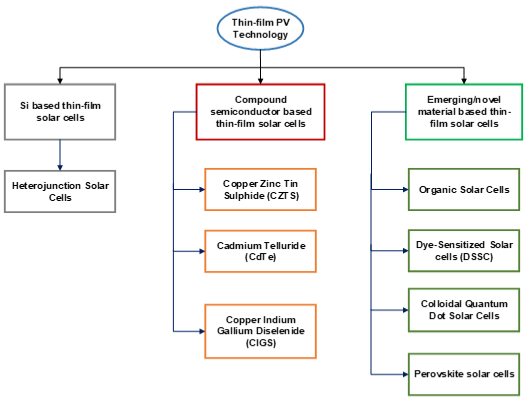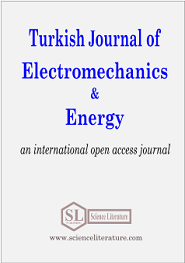
State of the art review on the Cu(In,Ga)Se2 thin-film solar cells
Abstract
Solar cell efficiency and durability are some of the critical research areas in the field of solar photovoltaic (PV) technology. Thin-film PV cells have been increasingly used in many industries and applications such as wearable electronics, self-energizing systems, on the roof of electrical vehicles, trains, solar boats, etc. Various types of thin-film solar cells have been investigated, produced, and exploited around the world. Different types of chalcopyrite semiconductors are used in high-efficiency thin-film solar cells, specifically in flexible PV cells. Cu(In,Ga)Se2 (CIGS) solar cells are promising technology among the thin-film solar cells due to their unique features. However, there are many challenges towards the development of the photovoltaic performance of thin-films and ultra-thin-film solar cells. The thickness and surface roughness of the thin-film layer which has a significant effect on the performance of cells, electron recombination, interface contact between thin-film layers, grain size, and grain boundaries can be mentioned as major problems. Many solutions for the cited problems have been investigated and reported. Alkali post-deposition treatment, for example, was noted to reduce the thickness of the absorber. Reduction in absorber thickness leads to a significant decrease in electron recombination which improves the PV performance of CIGS solar cells. Cs post-deposition treatment (Cs-PDT), on the other hand, improves cell performance by creating conduction band upward and valence band downshifts. Low thickness of absorber increase crystallinity and surface roughness of the CIGS absorber. A high amount of Ga concentration is reported to reduce the grain size and major loss of charge carrier. In addition to the high Ga amount, sulfurization is also responsible for decreasing the grain size and the fill factor (FF) of the PV cell.
Full Text:
PDFReferences
H. Ritchie, M. Roser, Renewable Energy, Our World Data, Dec., (2017).
O. Instruments, Solar cells from chalcopyrite-type thin films analysed by electron backscatter diffraction Introduction, Solar Energy, 5–8, (2007).
Paris Agreement, The United Nations Framework Convention on Climate Change, Paris agreement, France, (2016).
K. J. Yang et al., Comparison of chalcopyrite and kesterite thin-film solar cells, J. Ind. Eng. Chem., vol. 45, 78–84, (2017)
A. K. Ryad, A. M. Atallah, and A. Zekry, Photovoltaic Parameters Estimation Using Hybrid Flower Pollination with Clonal Selection Algorithm, Turkish J. Electromechanics Energy, 3(2), 15–21, (2018).
A. Seyhan, T. Altan, O. C. Ecer, and R. Zan, A Hydrogenated Amorphous Silicon (a-Si:H) Thin Films for Heterojunction Solar Cells: Structural and Optical Properties, Journal of Physics: Conference Series, 902(1), 012024, (2017)
M. Moreno, R. Ambrosio, A. Torres, A. Torres, P. Rosales, A. Itzmoyotl, and M. Domínguez, M. Amorphous, Polymorphous, and Microcrystalline Silicon Thin Films Deposited by Plasma at Low Temperatures, Crystalline and Non-crystalline Solids, 147, (2016).
NREL, Best Research-Cell Efficiencies, (2020) [Online]. Available: https://www.nrel.gov/pv/assets/pdfs/best-research-cell-efficiencies.20200406.pdf.
D. Wöhrle, D. Meissner, Organic solar cells, Advanced Materials, 3(3), 129-138, (1991).
K. Hara, Dye‐Sensitized Solar Cells, January. (2005).
A. Hagfeldt, G. Boschloo, L. Sun, L. Kloo, and H. Pettersson, Dye-sensitized solar cells, Chem. Rev., 110(11), 6595–6663, (2010).
C. Crowell, Researchers improve efficiency of organic solar PV cells to 15 percent, (2016), [Online], Available: https://solarbuildermag.com/news/organic-pv-cell-efficiency-improves-to-15-percent/.
M. Grätzel, Dye-sensitized solar cells, Journal of Photochemistry and Photobiology C: Photochemistry Reviews, 4(2), 145–153, (2003).
D. Suyitno, N. Rachmad, Z. Arifin, T. J. Saputra, M. A. Omid, and M. Yusuf, Effect of Natural and Synthetic Dyes on the Performance of Dye-Sensitized Solar Cells Based on ZnO Nanorods Semiconductor, Appl. Mech. Mater., vol. 699, 577–582, (2014).
Z. Arifin, S. Suyitno, M. A. Omid, A. Supriyanto, and L. Nulhakim, Electrospun AZO Electrodes and Solid-State Electrolyte for Dye-Sensitized Solar Cells, in The 12th Annual National Seminar Of Mechanical Engineering (SNTTM XII), October 23-24, Bandar Lampung, Indonesia, (2013).
K. Sharma, V. Sharma, and S. S. Sharma, Dye-Sensitized Solar Cells : Fundamentals and Current Status, Nanoscale research letters, 13(1), 381, (2018).
B. Bouanani, A. Joti, F. S. B. Bouiadjra, and A. Kadid, Band gap and thickness optimization for improvement of CIGS/CIGS tandem solar cells using Silvaco software, Optik, vol. 204, 164217, (2020).
M. Kaelin, D. Rudmann, and A. N. Tiwari, Low cost processing of CIGS thin film solar cells, J. Sol. Energy, 77(6), 749–756, (2004).
S. Siebentritt, Chalcopyrite compound semiconductors for thin film solar cells, Curr. Opin. Green Sustain. Chem., vol. 4, 1–7, (2017).
Z. Xuan et al., CIGS Solar Cell, (2011), [Online], Available:https://www.slideshare.net/Funk98/how-and-why-is-the-cost-of-electricity-from-cigs-solar-cells-falling-7724815.
M. Powalla, S. Paetel, E. Ahlswede, R. Wuerz, C. D. Wessendorf, and T. M. Friedlmeier, Thin-film solar cells exceeding 22% solar cell efficiency: An overview on CdTe-, Cu(In,Ga)Se2-, and perovskite-based materials, Appl. Phys. Rev., 5(4), 041602, (2018).
T. Y. Lin et al., Alkali-induced grain boundary reconstruction on Cu(In,Ga)Se2 thin film solar cells using cesium fluoride post deposition treatment, Nano Energy, No. 68, 104299, (2020).
B. Namnuan, V. Amornkitbamrung, and S. Chatraphorn, Effects of Cu(In,Ga)3Se5 defect phase layer in Cu(In,Ga)Se2 thin film solar cells, J. Alloys Compd., vol. 800, 305–313, (2019).
M. Nakamura, K. Yamaguchi, Y. Kimoto, Y. Yasaki, T. Kato, and H. Sugimoto, Cd-Free Cu(In,Ga)(Se,S)2 thin-film solar cell with record efficiency of 23.35%, IEEE J. Photovoltaics, 9(6), 1863–1867, (2019).
W. Li et al., Improvement of the crystallinity and efficiency of wide-gap CIGS thin film solar cells with reduced thickness, Mater. Lett., vol. 244, 43–46, (2019).
J. Ramanujam and U. P. Singh, Copper indium gallium selenide based solar cells - A review, Energy Environ. Sci., 10(6), 1306–1319, (2017).
R. Paper et al., Effects of Cu(In,Ga)3Se5 defect phase layer in Cu(In,Ga)Se2 thin film solar cells, J. Phys. Chem. C, 5(6), 17757–17764, (2019).
T. Y. Lin et al., Alkali-induced grain boundary reconstruction on Cu(In,Ga)Se2 thin film solar cells using cesium fluoride post deposition treatment, Nano Energy, vol. 68, 104299, (2020).
H. Aboulfadl, J. Keller, J. Larsen, L. Riekehr, M. Edoff, and C. Platzer-Björkman, Microstructural Characterization of Sulfurization Effects in Cu(In,Ga)Se2 Thin Film Solar Cells, Microsc. Microanal., 25(2), 532–538, (2019).
E. Ghanbari, M. Zahedifar, and M. Moradi, Improving CIGS thin film by evaporation of CIGS nanoparticles without phase change, Appl. Phys. A Mater. Sci. Process., 125(5), 1–9, (2019).
T. Y. Lin et al., Alkali-induced grain boundary reconstruction on Cu(In,Ga)Se2 thin film solar cells using cesium fluoride post deposition treatment, Nano Energy, vol. 68, 104299, (2020),
E. Ghanbari, M. Zahedifar, and M. Moradi, Improving CIGS thin film by evaporation of CIGS nanoparticles without phase change, Appl. Phys. A Mater. Sci. Process., 125(5), 1–9, (2019).
J. Goffard, F. Mollica, A. Cattoni, C. Sauvan, and P. Lalanne, Light Trapping in Ultrathin CIGS Solar Cells with Nanostructured Back Mirrors, 7(5), 1433–1441, (2017).
J. Keller et al., Grain boundary investigations on sulfurized Cu(In,Ga)(S,Se)2 solar cells using atom probe tomography, Sol. Energy Mater. Sol. Cells, vol. 117, 592–598, (2013).
J. Ramanujam and U. P. Singh, Copper indium gallium selenide based solar cells - A review, Energy and Environmental Science, Royal Society of Chemistry, 10(6), 1306–1319, (2017).
URN: https://sloi.org/urn:sl:tjoee52163
Copyright (c) 2020 Turkish Journal of Electromechanics and Energy

This work is licensed under a Creative Commons Attribution-NonCommercial 4.0 International License.

 Indexed in:
Indexed in:















